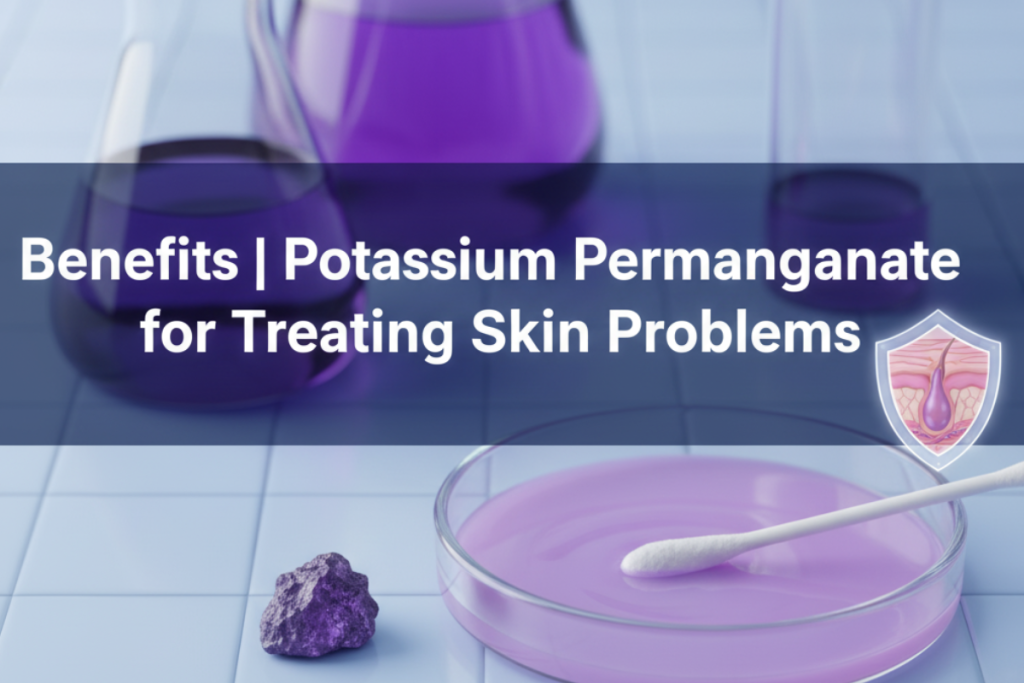Potassium permanganate is a well-established compound used in dermatology for its cleansing and healing abilities. It holds a long history of medical application in treating various skin conditions. Midway through this discussion, we will explore potassium permanganate uses for skin, understanding how this crystal compound supports recovery in conditions involving infection, moisture, or irritation. This content draws upon clinical experience and expert consensus to provide a professional, trustworthy guide for readers seeking accurate and useful information.
What Is Potassium Permanganate and How Does It Work on the Skin
Potassium permanganate, often recognized by its deep purple color, acts as a mild antiseptic and astringent. When diluted in water, it releases oxygen, which helps cleanse damaged tissue and reduces microbial presence. It is typically used in the form of a weak solution—usually pale pink in color—to prevent irritation or chemical burns. In dermatological care, it is applied as a soak, compress, or bath, helping reduce infection and dryness in affected skin areas.
Its mechanism centers on oxidation: it reacts with organic material, cleansing the surface of wounds and inflamed skin. This action helps dry out weeping lesions and prevents the growth of bacteria and fungi, supporting faster and cleaner healing.
Skin Conditions That Benefit from Potassium Permanganate
Eczema and Dermatitis
Patients with weeping eczema often struggle with oozing and crust formation, creating an environment prone to infection. Diluted potassium permanganate helps dry the affected areas and provides an antiseptic effect that reduces bacterial load. Short soaks or compresses can calm irritation and prepare the skin for subsequent treatments such as emollients or medicated creams.
Fungal and Bacterial Infections
In mild skin infections, particularly those caused by fungi or bacteria, potassium permanganate assists by cleansing infected areas and reducing odor and discharge. It is often recommended for conditions like athlete’s foot, infected blisters, and impetigo. Its drying effect helps inhibit the moisture that microorganisms need to thrive.
Ulcers and Wound Care
Open wounds, ulcers, or blistered areas benefit from potassium permanganate’s oxidizing properties. It helps remove necrotic tissue and reduce infection risk. This compound is sometimes used in early wound management stages where gentle cleansing and drying are required before applying dressings or ointments.
Benefits of Using Potassium Permanganate for Skin
Antimicrobial Protection
The primary advantage of potassium permanganate lies in its ability to limit microbial growth. Its oxidizing power disrupts bacterial and fungal cells, making it valuable in managing infected or high-risk skin areas.
Drying and Astringent Action
Excess moisture can prolong inflammation and infection. Potassium permanganate’s drying effect helps control fluid discharge, reduce swelling, and promote the formation of new, healthy skin layers.
Relief from Itching and Discomfort
Patients often experience relief from itching and burning sensations when potassium permanganate soaks are used correctly. This is because its cleansing effect helps remove irritants and secretions that aggravate sensitive skin.
Support for Healing
By cleansing wounds and reducing infection risk, potassium permanganate helps create conditions that favor natural healing. It is most effective as a short-term supportive treatment rather than a long-term solution.
Safety and Proper Use
Correct Dilution
Potassium permanganate must always be diluted before use. A safe concentration produces a light pink solution. Stronger solutions can irritate or burn the skin. The crystals should be completely dissolved before applying the solution to the skin.
Application Methods
Common applications include soaks, baths, or compresses. The affected area is usually immersed or covered for about 10 minutes, followed by gentle drying. Treatment frequency depends on the condition—often once or twice daily until improvement is visible.
Side Effects and Precautions
Possible side effects include dryness, irritation, or temporary staining of the skin and nails. The compound should not be used on sensitive areas such as the face, eyes, or mucous membranes. It is strictly for external use and should never be ingested. Gloves are recommended when preparing or applying the solution to prevent staining.
Professional Guidance
Before beginning treatment, consulting a healthcare provider or dermatologist is essential. Professional evaluation ensures that potassium permanganate is suitable for the skin problem and used in the correct concentration and duration.
Expert Recommendations for Best Results
- Use freshly prepared solutions for each session.
- Keep the solution pale pink; darker shades are too concentrated.
- Avoid using it on dry or cracked skin unless advised by a professional.
- Combine with prescribed moisturizers or creams once the area has dried.
- Stop use immediately if pain, burning, or irritation develops.
- Store crystals safely out of reach of children.
Frequently Asked Questions
Can I prepare potassium permanganate at home?
Yes, but it must be diluted correctly. Use only a few crystals in a large bowl or bucket of warm water until the color turns light pink. Overly strong solutions can cause burns.
Is it safe for daily use?
Daily use is possible for a short duration—typically a few days—until symptoms improve. Long-term use may overly dry the skin.
Can I use potassium permanganate on my face?
No, the facial skin is delicate, and contact near the eyes or mouth can cause irritation. It is meant for limbs, hands, or feet rather than the face.
Does it permanently stain the skin?
No. Any staining is temporary and fades as the outer skin cells shed naturally.
Can children use potassium permanganate soaks?
Yes, under medical supervision. The solution must be extremely diluted, and contact time should be brief.
Potassium permanganate remains a valuable component of dermatological care when used responsibly. Its ability to cleanse, dry, and protect affected skin makes it a practical option for weeping eczema, infected wounds, and fungal infections. With proper dilution and professional guidance, it offers an effective method for supporting skin recovery and maintaining hygiene during treatment.







